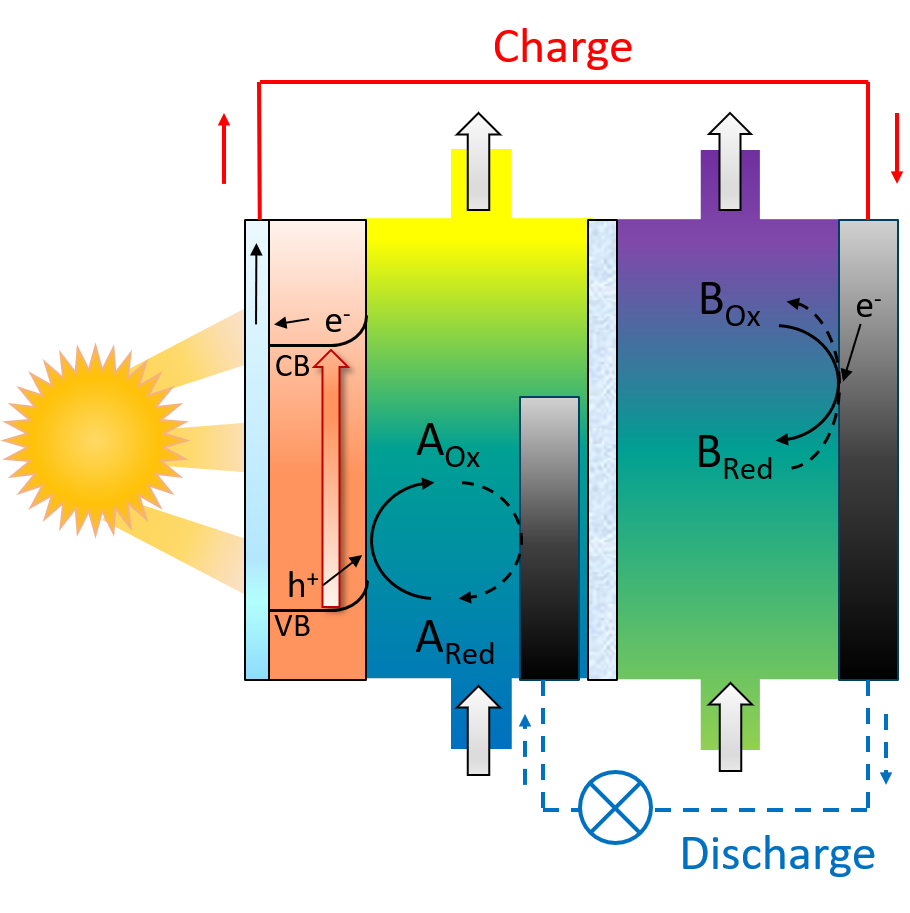03ET6088A

| Period: | 01.08.2017 – 31.08.2020 |
|---|---|
| Partner: | |
| Funder: | Bundesministerium für Wirtschaft und Energie |
| Project Manager: | Dr. Christoph Haisch; Nicky Bogolowski |
| Research Group: | Electrochemistry, Chemical Technology |
Within this joint project the advantages of solar cells and redox flow batteries [1-3] for the efficient storage of electricity from renewable energy sources shall be combined for the development of a photo redox flow battery (Photo-RFB, Fig. 1). We will directly convert sunlight into electrochemical energy stored in a redox flow battery and make use of the accumulated solar thermal energy in the new devices. Moreover, the Photo-RFB will help reducing the load on the power grid by conventional electrochemical flow battery charging. For this purpose, a robust testing setup will be developed and a reference system established. Design, characterization and optimization of photoanode materials [4] that match the electrochemical properties of new, to be developed water-soluble, organic electrolytes [5] especially redox polymers [6,7] as well as the corresponding membrane materials are main points of this project. Besides the development of the system and all of its components, essential information about efficiency and limiting factors of this new technology will be collected. Finally, a new modular cell design of Photo-RFB cells has to be engineered for the low cost, industrial scale production of such devices. Fig. 1 – Scheme of a direct photochargeable redox flow battery (Photo-RFB).
Fig. 1 – Scheme of a direct photochargeable redox flow battery (Photo-RFB).
Different photo-electrodes and electrolytes are developed and optimized in this project. The project partners JenaBatteries GmbH and Friedrich-Schiller-Universität Jena (Prof. Dr. U. S. Schubert) are responsible for the development and optimization of suitable electrolytes while the Volterion GmbH designs a readily scalable cell and module concept. Furthermore, the development of a demonstrator in close collaboration with all project partners is planned.
[1] M. Yu, W. D. McCulloch, Z. Huang, B. B. Trang, J. Lu, K. Amine, Y. Wu, J. Mater. Chem. A, 0 (2016), 1 17.
[2] J. Azevedo, T. Seipp, J. Burfeind, C. Sousa, A. Bentien, J. P. Araújo, A. Mendes, Nano Energy, 22 (2016), 396 405.
[3] Z. Wei, D. Liu, C. Hsu, F. Liu, Electrochem. Commun., 45 (2014), 79 82.
[4] R. Marschall, Adv. Funct. Mater., 24 (2014), 2421 2440.
[5] B. Huskinson, M. P. Marshak, C. Suh, S. Er, M. R. Gerhardt, C. J. Galvin, X. Chen, A. Aspuru-Guzik, R. G. Gordon, M. J. Aziz, Nature, 505 (2014), 195 198.
[6] J. Winsberg, T. Hagemann, T. Janoschka, M. D. Hager, U. S. Schubert, Angew. Chem. Int. Ed., 56 (2017), 686 711.
[7] T. Janoschka, N. Martin, U. Martin, C. Friebe, S. Morgenstern, H. Hiller, M. D. Hager, U. S. Schubert, Nature, 527 (2015), 78 81.
back
Funding number: 03ET6088A